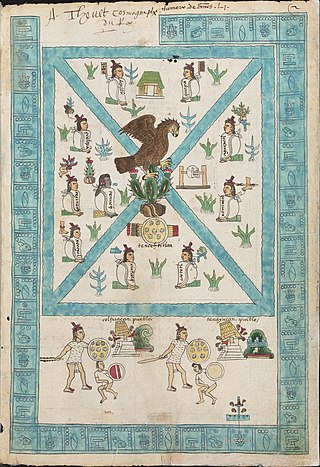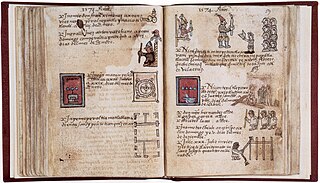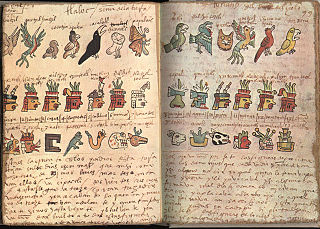Related Research Articles

Maya codices are folding books written by the pre-Columbian Maya civilization in Maya hieroglyphic script on Mesoamerican bark paper. The folding books are the products of professional scribes working under the patronage of deities such as the Tonsured Maize God and the Howler Monkey Gods. The codices have been named for the cities where they eventually settled. The Dresden codex is generally considered the most important of the few that survive.
The Anales de Tlatelolco is a codex manuscript written in Nahuatl, using Latin characters, by anonymous Aztec authors. The text has no pictorial content. Although there is an assertion that the text was a copy of one written in 1528 in Tlatelolco, only seven years after the fall of the Aztec Empire, James Lockhart argues that there is no evidence for this early date of composition, based on internal evidence of the text. However, he supports the contention that this is an authentic conquest account, arguing that it was composed about 20 years after the conquest in the 1540s, and contemporaneous with the Cuernavaca censuses. Unlike the Florentine Codex and its account of the conquest of the Aztec Empire, the Annals of Tlatelolco remained in Nahua hands, providing authentic insight into the thoughts and outlook of the newly conquered Nahuas.

Aztec codices are Mesoamerican manuscripts made by the pre-Columbian Aztec, and their Nahuatl-speaking descendants during the colonial period in Mexico.

The Aubin Codex is an 81-leaf Aztec codex written in alphabetic Nahuatl on paper from Europe. Its textual and pictorial contents represent the history of the Aztec peoples who fled Aztlán, lived during the Spanish conquest of the Aztec Empire, and into the early Spanish colonial period, ending in 1608.

The Codex Borbonicus is an Aztec codex written by Aztec priests shortly before or after the Spanish conquest of the Aztec Empire. It is named after the Palais Bourbon in France and kept at the Bibliothèque de l'Assemblée Nationale in Paris. The codex is an outstanding example of how Aztec manuscript painting is crucial for the understanding of Mexica calendric constructions, deities, and ritual actions.

The Codex Telleriano-Remensis, produced in sixteenth century Mexico on European paper, is one of the finest surviving examples of Aztec manuscript painting. It holds the earliest written evidence of earthquakes in the Americas. Its Latinized name comes from Charles-Maurice Le Tellier, archbishop of Reims, who had possession of the manuscript in the late 17th century.
Marcelle Lalou (1890–1967) was a 20th-century French Tibetologist. Her major contribution to Tibetology was the cataloging of the entire Pelliot collection of Old Tibetan manuscripts from Dunhuang at the Bibliothèque nationale de France. In addition to her cataloging work, she wrote articles on various aspects of Old Tibet, and she published a Tibetan textbook. Some of her most notable students include Rolf A. Stein and J. W. de Jong.
The Codex en Cruz is a pictorial Aztec codex consisting of a single piece of amatl paper. It records historical events, such as the succession of rulers, wars, and famines, of the 15th and 16th centuries. The codex centers on the city of Texcoco, but also includes information pertaining to Tenochtitlan, Tepetlaoztoc and Chiautla.

The Codex of Tlatelolco is a pictorial central Mexican manuscript containing a history of events occurring in Tlatelolco, from before 1550 to after 1564, in the period before and after the Spanish conquest of the Aztec Empire. Due to its name, it is sometimes confused with the Latin script, the manuscript Anales de Tlatelolco, also sometimes called the same name.

The Codex Tudela is a 16th-century pictorial Aztec codex. It is based on the same prototype as the Codex Magliabechiano, the Codex Ixtlilxochitl, and other documents of the Magliabechiano Group.

The Codex Azcatitlan is an Aztec codex detailing the history of the Mexica and their migration journey from Aztlán to the Spanish conquest of the Aztec Empire. The exact date when the codex was produced is unknown, but scholars speculate it was crafted some time between the mid-16th and 17th centuries. The name of this important Mexica pictorial manuscript was suggested by its first editor, Robert H. Barlow, who erroneously interpreted the anthill on page 2 as the glyph for “Aztlán.” In the Bibliothèque nationale de France, where it is housed, it is known as Histoire mexicaine, [Manuscrit] Mexicain 59–64.

The Codex Tovar is a historical Mesoamerican manuscript from the late 16th century written by the Jesuit Juan de Tovar and illustrated by Aztec painters, entitled Historia de la benida de los Yndios a poblar a Mexico de las partes remotas de Occidente. The codex is close in content, but not identical, to the Ramírez Codex. It is currently kept at the John Carter Brown Library, in Providence, Rhode Island, United States.
Henry Bigger Nicholson who published under the name H.B. Nicholson, was a scholar of the Aztecs. His major scholarly monograph is Topiltzin Quetzalcoatl: The Once and Future Lord of the Toltecs (2001).

Eugène Boban or Boban-Duvergé (1834–1908) was a French antiquarian. He was the official archaeologist of the court of Maximilian I of Mexico, and a member of the French Scientific Commission in Mexico. From time to time he sold crystal skulls, one which is now in the Musée du Quai Branly and another in the British Museum.

The Codex Xolotl is a postconquest cartographic Aztec codex, thought to have originated before 1542. It is annotated in Nahuatl and details the preconquest history of the Valley of Mexico, and Texcoco in particular, from the arrival of the Chichimeca under the king Xolotl in the year 5 Flint (1224) to the Tepanec War in 1427.
Codex Chimalpopoca or Códice Chimalpopoca is a postconquest cartographic Aztec codex which is officially listed as being in the collection of the Instituto Nacional de Antropología e Historia located in Mexico City under "Collección Antiguo no. 159". It is best known for its stories of the hero-god Quetzalcoatl. The current whereabouts of the codex are unknown. It appears to have been lost in the mid-twentieth century. Study of the codex is therefore necessarily provided only through copies and photographs. The codex consists of three parts, two of which are more important, one that regards the pre-Hispanic history of Central Mexico, the Anales de Cuauhtitlan and the other that regards the study of Aztec cosmology, the Leyenda de los Soles.

The Dumbarton Oaks birthing figure is a possibly Aztec scapolite figurine of a woman giving childbirth in a squatting position. Housed in the Dumbarton Oaks collection, United States, the figurine is considered by several scholars to be a pre-Columbian artwork, while others believe it was made in modern times, possibly in the 19th century. The figurine measures 20.2 cm in height.
François Déroche is an academic and specialist in Codicology and Palaeography. He is a professor at the Collège de France, where he is holding "History of the Quran Text and Transmission" Chair.

Mesoamerican codices are manuscripts that present traits of the Mesoamerican indigenous pictoric tradition, either in content, style, or in regards to their symbolic conventions. The unambiguous presence of Mesoamerican writing systems in some of these documents is also an important, but not defining, characteristic, for Mesoamerican codices can comprise pure pictorials, native cartographies with no traces of glyphs on them, or colonial alphabetic texts with indigenous illustrations. Perhaps the best-known examples among such documents are Aztec codices, Maya codices, and Mixtec codices, but other cultures such as the Tlaxcaltec, the Purépecha, the Otomi, the Zapotecs, and the Cuicatecs, are creators of equally relevant manuscripts. The destruction of Mesoamerican civilizations resulted in only about twenty known pre-Columbian codices surviving to modern times.

The Codex Ixtlilxochitl is a pictorial Aztec Codex created between 1580 and 1584, after the arrival of the Conquistadors and during the early Spanish colonial period. It is a record of the past ceremonies and holidays observed at the Great Teocalli of the Aztec city of Texcoco, near modern-day Mexico City, and contains visual representations of rulers and deities with association to Texcoco. The existence of this codex is a demonstration of the cultural assimilations and interactions between native Aztecs, Spanish colonists, and mestizos that occurred during the 17th century in Mexico as the colonies developed and their residents, of all cultures, endeavored to find a balance between native tradition and colonial innovation. Contrasting with the attitude of colonists from the prior century of striving for a complete annihilation of all native culture, this codex served as a quasi-translator between native and European cultural languages, and denotes an occurrence of European fascination with the unknown resulting in a valuable preservation of the native cultures they had previously sought to destroy.
References
- Robertson, Donald (1954). "A Note on the Last Pages of the Codex Mexicanus". Journal de la Société des Américanistes. 43: 219–221.
- Robertson, Donald (1994). Mexican Manuscript Painting of the Early Colonial Period: The Metropolitan Schools. University of Oklahoma Press. pp. 122–125.
- Mengin, Ernest (1952). "Commentaire du Codex Mexicanus Nos. 23-24 de la Bibliothèque Nationale de Paris". Journal de la Société des Américanistes. 41 (2): 387–498. doi:10.3406/jsa.1952.3743.
